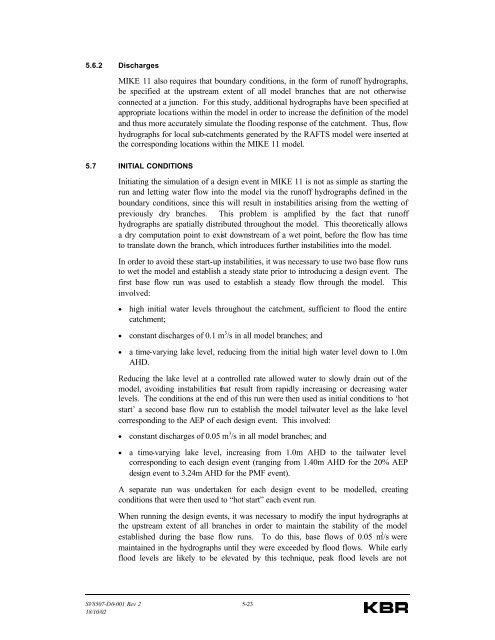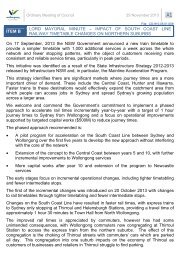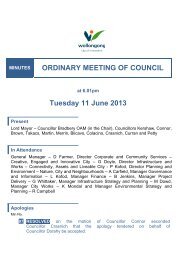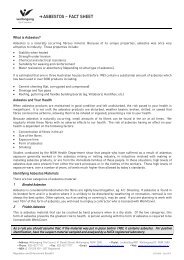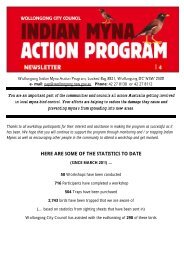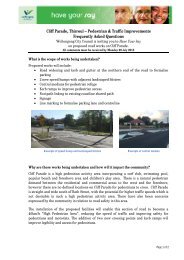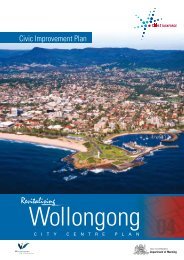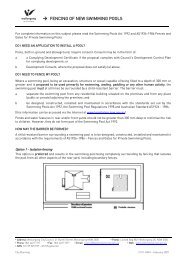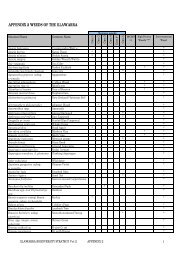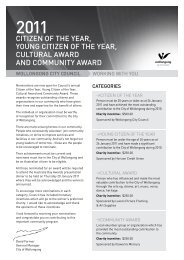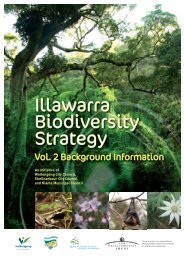Minnegang Creek Flood Study Report - Wollongong City Council
Minnegang Creek Flood Study Report - Wollongong City Council
Minnegang Creek Flood Study Report - Wollongong City Council
- No tags were found...
You also want an ePaper? Increase the reach of your titles
YUMPU automatically turns print PDFs into web optimized ePapers that Google loves.
5.6.2 DischargesMIKE 11 also requires that boundary conditions, in the form of runoff hydrographs,be specified at the upstream extent of all model branches that are not otherwiseconnected at a junction. For this study, additional hydrographs have been specified atappropriate locations within the model in order to increase the definition of the modeland thus more accurately simulate the flooding response of the catchment. Thus, flowhydrographs for local sub-catchments generated by the RAFTS model were inserted atthe corresponding locations within the MIKE 11 model.5.7 INITIAL CONDITIONSInitiating the simulation of a design event in MIKE 11 is not as simple as starting therun and letting water flow into the model via the runoff hydrographs defined in theboundary conditions, since this will result in instabilities arising from the wetting ofpreviously dry branches. This problem is amplified by the fact that runoffhydrographs are spatially distributed throughout the model. This theoretically allowsa dry computation point to exist downstream of a wet point, before the flow has timeto translate down the branch, which introduces further instabilities into the model.In order to avoid these start-up instabilities, it was necessary to use two base flow runsto wet the model and establish a steady state prior to introducing a design event. Thefirst base flow run was used to establish a steady flow through the model. Thisinvolved:• high initial water levels throughout the catchment, sufficient to flood the entirecatchment;• constant discharges of 0.1 m 3 /s in all model branches; and• a time-varying lake level, reducing from the initial high water level down to 1.0mAHD.Reducing the lake level at a controlled rate allowed water to slowly drain out of themodel, avoiding instabilities that result from rapidly increasing or decreasing waterlevels. The conditions at the end of this run were then used as initial conditions to ‘hotstart’ a second base flow run to establish the model tailwater level as the lake levelcorresponding to the AEP of each design event. This involved:• constant discharges of 0.05 m 3 /s in all model branches; and• a time-varying lake level, increasing from 1.0m AHD to the tailwater levelcorresponding to each design event (ranging from 1.40m AHD for the 20% AEPdesign event to 3.24m AHD for the PMF event).A separate run was undertaken for each design event to be modelled, creatingconditions that were then used to “hot start” each event run.When running the design events, it was necessary to modify the input hydrographs atthe upstream extent of all branches in order to maintain the stability of the modelestablished during the base flow runs. To do this, base flows of 0.05 m 3 /s weremaintained in the hydrographs until they were exceeded by flood flows. While earlyflood levels are likely to be elevated by this technique, peak flood levels are notSV8507-D0-001 Rev 2 5-2318/10/02


